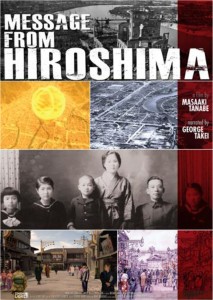CSUN Animation Faculty, Students Helped Rebuild Memories of Hiroshima Life Pre-Bombing
The atomic bombing of Hiroshima in August 1945 destroyed the city’s infrastructure and killed an estimated 90,000–146,000 people. It also wiped out an entire culture in an instant.
“Message from Hiroshima,” a Japanese documentary directed by bombing survivor Masaaki Tanabe and narrated by actor George Takei, tells the stories of Hiroshima survivors with the help of computer-generated imagery by CSUN animation faculty and students. Originally released in Japan in 2010, the U.S. release was made available by Cinema Libre Studio this month, in time for the 70th anniversary of the bombing.
CSUN animation professor Mark Farquhar and a team of students helped to digitally recreate neighborhoods of the Nakajima district, based on the memories of the hibakusha — the Japanese word for atomic bomb survivor. Along with Los Angeles producers/animators Yuriko Senoo and Adam Dykstra, Farquhar produced the English-language version through collaboration with Japanese university students and professionals to create computer-generated imagery of detailed buildings, roads, people and even things like bicycles. The artists looked at old plans and pictures of areas and buildings, such as the neighborhood’s shops and the iconic Hiroshima dome, which withstood the bomb.
“We were trying to interpret the memories of the survivors,” Farquhar said. “We wanted to show detail, but also recreate the feel, textures, colors and types of objects that were there.”
Farquhar said that Tanabe wanted to collaborate with Japanese and American students from a new generation.
“Tanabe-san came to campus for a screening [of] the Japanese version, and he was impressed with all of the students working on this project,” Farquhar said. “They were working on it for the right reasons, and they were very aware of its meaning and importance. It wasn’t just work to them — they got a lot out of being able to collaborate and contribute.”
Tanabe was orphaned at an early age. His mother and brother died in the bombing, and his father died later from exposure. He did not talk about his experience for 60 years, until he decided that he needed to preserve the hibakushas’ memories. His position as a survivor helped gain access to the subjects in the film in ways that other filmmakers might not have.
“The testimonies and interviews in this documentary are very powerful,” Farquhar said. “Their respect for life is incredible. The people who survived are not looking for revenge — it is a message of peace. Their anger is turned toward this hope that this never happens again. That message and idea are very relevant today.”
Farquhar said that contributing to the documentary was an inspiring experience. He was thankful to be a part of a project that was not about the political aspects of the bombing, but one that preserves human stories.
“There have been millions of people who died in atrocities, and sometimes it’s hard to understand the significance because it’s such a big number,” Farquhar said. “It’s not just buildings and not just individuals — it’s an extinction of a culture. Working on a project like this helps us remember there is a cost in any of these wars and atrocities, and it’s important to keep that memory.”
“Message from Hiroshima” will be screened at CSUN in the fall; the time and date are to be decided. To find out more information about the campus screening and other screenings in Los Angeles, please visit the Facebook page at www.facebook.com/messagefromhiroshima.


 experience
experience